Intel's Core i7 870 & i5 750, Lynnfield: Harder, Better, Faster Stronger
by Anand Lal Shimpi on September 8, 2009 12:00 AM EST- Posted in
- CPUs
3dsmax 9 - SPECapc 3dsmax CPU Rendering Test
Today's desktop processors are more than fast enough to do professional level 3D rendering at home. To look at performance under 3dsmax we ran the SPECapc 3dsmax 8 benchmark (only the CPU rendering tests) under 3dsmax 9 SP1. The results reported are the rendering composite scores:
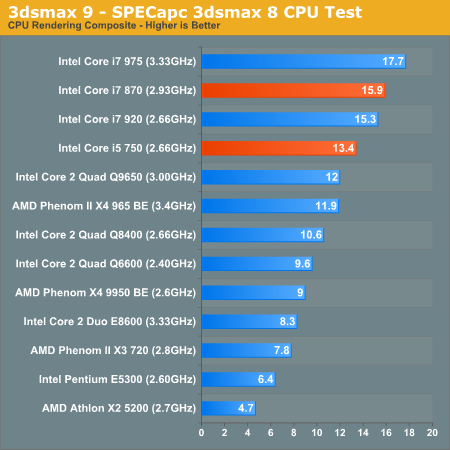
And we're back down to utter dominance yet again. The i5 750 is 12.6% faster than the Phenom II X4 965 BE and 18.8% cheaper. Harder, better, faster stronger.
Blender 2.48a
Blender is an open source 3D modeling application. Our benchmark here simply times how long it takes to render a character that comes with the application.
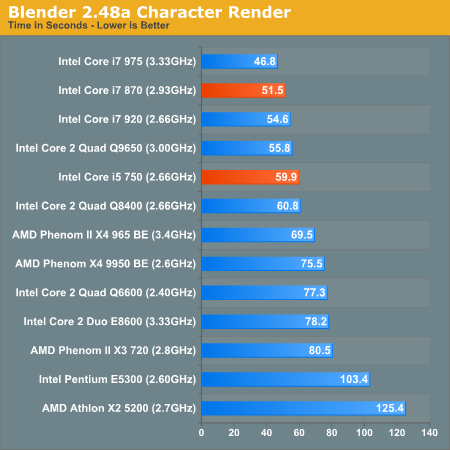
To get Blender to perform right on Lynnfield we actually had to update our graphics drivers. It looks like the on-die PCIe does require the latest NVIDIA/ATI drivers to work properly. The results aren't unusual; Intel has done very well in these tests and Lynnfield continues to dominate. The i5 750 is a bit slower than the 920 (and Q9650) thanks to its missing HT support.
Cinebench R10
Created by the Cinema 4D folks we have Cinebench, a popular 3D rendering benchmark that gives us both single and multi-threaded 3D rendering results.
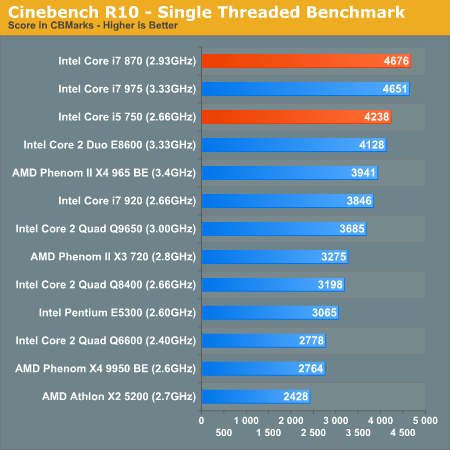
The single threaded benchmark tells us everything we need to know. The Core i5 750 and i7 870 are two of the fastest processors we've ever tested at single-threaded applications. Very few microprocessors will be able to retire instructions from a single thread as quickly as Lynnfield. This is actually very noticeable in simply using the OS. Many tasks still aren't multithreaded but they execute very, very fast on Lynnfield.
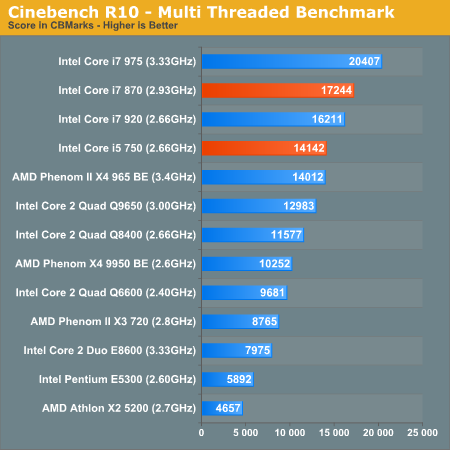
Crank up the threads and Lynnfield is still competitive. Because it's missing Hyper Threading, the i5 750 is barely faster than the Phenom II X4 965 BE. Although I understand Intel wanting to segment its product line, it seems that the i5's missing HT goes a bit too far.
POV-Ray 3.73 beta 23 Ray Tracing Performance
POV-Ray is a popular, open-source raytracing application that also doubles as a great tool to measure CPU floating point performance.
I ran the SMP benchmark in beta 23 of POV-Ray 3.73. The numbers reported are the final score in pixels per second.
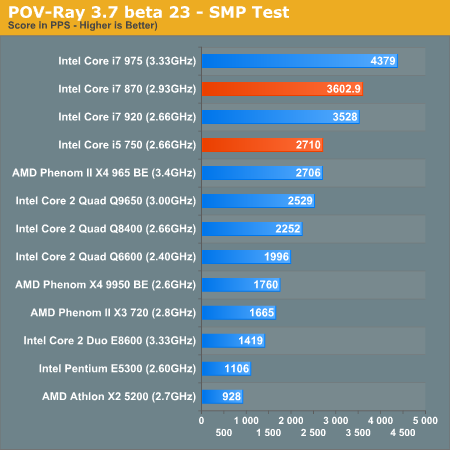
We see the same results under POV-Ray. Regardless of thread count, Lynnfield delivers the best performance possible short of a $1000 CPU.










343 Comments
View All Comments
Jamahl - Tuesday, September 8, 2009 - link
Digusting! How much money did intel bung you for this disgrace?strikeback03 - Tuesday, September 8, 2009 - link
How is that disgusting? It is the stock configuration of the processor. They are not doing all this testing as an e-pissing contest of who has better performance per clock, it is a comparison of retail products in real-world applications. If (and according to the review, when) AMD has something similar, I'd imagine they will test with that turned on too.Jamahl - Tuesday, September 8, 2009 - link
Why not benchmark the Phenom 2 with fusion for gaming anand???Gary Key - Tuesday, September 8, 2009 - link
"Why not benchmark the Phenom 2 with fusion for gaming anand??? "Have you actually tried using Fusion with Windows 7 x64? It is a total mess. I will be happy to show some results with it, most will say DNF, but that might not make you happy. ;) That said, AMD is working on it, especially trying to get it to play nice with AOD.
In the meantime, here is the current list of items to watch out for - http://game.amd.com/us-en/drivers_fusion.aspx?p=3&...">http://game.amd.com/us-en/drivers_fusion.aspx?p=3&... .
Jamahl - Tuesday, September 8, 2009 - link
What? It's AMD's fault that an unreleased 64-bit os is causing issues with their software?How many people are using Window 7 64 bit who visit this website?
Gary Key - Tuesday, September 8, 2009 - link
It is just as bad in 64-bit Vista. I imagine a fair amount of people that visit the site are using the RTM version of Win7.Jamahl - Tuesday, September 8, 2009 - link
were you benchmarking a processor at 2.66 gigahertz or a processor at 3.2 gigahertz?Gary Key - Tuesday, September 8, 2009 - link
Do you and SnakeOil live in the same house or is the IP address just that similar? LOL.. The processors were benched as they come out of the box. For Lynnfield that means turbo was on as we stated in the article and here in the comments. For Bloomfield, that also means turbo was on, just as it comes out of the retail box.If you check all the other reviews on the web at the main sites, everyone tested with turbo on in the primary benchmarks. So I guess you can say there is a huge conspiracy between us to actually utilize the processors as Intel intended for the users.
Apparently, we all failed at covering it up, so congratulations on discovering the Freeturbomasons. A now not so secret fraternal organization bent on world domination through the use of turbo frequencies inside processors carrying the blue "i" logo.
For the AMD Phenom II x4 series, they were benched with all cores enabled just as they come out of the box, even though you can disable each core in the BIOS just like you can disable turbo on the i7/i5. I guess to make things fair, we should disable the cores on the 965 BE as having that "feature" turned on is cheating.
Anyway, thanks for making my day, I needed some much deserved laughter. :)
Chlorus - Tuesday, September 8, 2009 - link
Seeing as how Fusion isn't even out yet, that would be hard to do...go troll somewhere else. What is with the idiots coming out of the woodwork on this post? You've got the standard fanboys, as well as insecure LGA-1366 owners who feel the need to defend their purchase, and insecure purchasers of 1156 products who are afraid their choice might be bested in a benchmark somewhere.Roland00 - Tuesday, September 8, 2009 - link
Would you please rerun page 9 with an overclocked 975 and the 870. I am wondering how much the difference will grow when the gpus are fed more information due to the faster cpus. Something like 3.8 to 4.0 ghz on both cpus with turbo off (a good overclock yet not in the unreasonable area)If you are investing 400+ dollars in gpus, and you are building it yourself you are probably going to overclock.